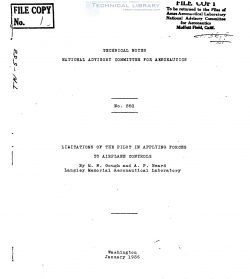naca-tn-550
- Version
- 137 Downloads
- 912.25 KB File Size
- 1 File Count
- November 25, 2016 Create Date
- November 25, 2016 Last Updated
National Advisory Committee for Aeronautics, Technical Notes - Limitations of the Pilot in Applying Forces to Airplane Controls

The forces that a pilot might exert on the controls
of an airplane are of interest in connection with the de—
sign of control surfaces and of operating mechanisms, and
also in connection with studies of controllability and _
maneuverability. The approximate physical limitations _of'
the pilot and the magnitude of the forces he can exert as
affected by the positions of the controls relative to his
seat with the airplane in.various attitudes should be
known. Pilots are usually able to describe the forces
required to operate the controls only in such general
terms as “heavy" or “light." The meaning of such terms
is dependent on.various factors, for example, whether the
force is a pull or a push,_is lateral or longitudinal,
and is applied with the hands or the feet.
Very little Qualitative information exists regarding.
the relative magnitude of the forces which pilots actual—
ly apply or which they regard as satisfactory. The tests
reported in reference 1 were _concerned with a study of
the time required to apply stick forces of various magni-
tudes.
In the present investigation measur.ements were made
of the maximum forces that could be applied and maintained
for several second's on the stick and rudder pedals as nor-
mally used for operating the ailerons, the elevators, and
the rudder. The influence of the location of control—
stick levers, or pedals, relative to the pilot‘s seat and
of the attitude of the airplane in space was studied.
Comments were also made to determine. the accuracy with
which applied forces could be estimated. A cockpit model
that could be rotated to any desired attitude to simulate
various flight conditions was used and the measurements
were made with the Committee's two test pilots as sub-
jects. Both pilots are rightqhanded and the forces were
applied only With the right hand and the right foot.
| File | Action |
|---|---|
| naca-tn-550 Limitations of the Pilot in Applying Forces to Airplane Controls.pdf | Download |

Comment On This Post